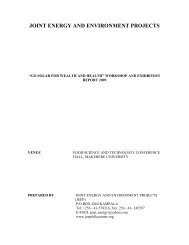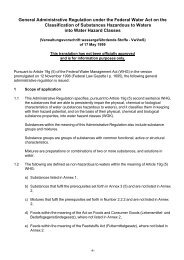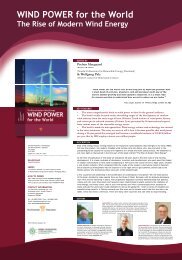You also want an ePaper? Increase the reach of your titles
YUMPU automatically turns print PDFs into web optimized ePapers that Google loves.
Biomass Typical gas yields<br />
Methane VS<br />
m 3 biogas/ m 3 methane/ % %<br />
kg DM kg VS of TS<br />
Pig slurry 0.37 0.32 65 75<br />
Cattle slurry 0.24 0.21 65 75<br />
Mink slurry 0.40 0.35 65 75<br />
Deep bedding 0.24 – 0.37 0.21 – 0.32 65 75<br />
Chicken manure 0.40 0.35 65 75<br />
Flotation sludge from sewage<br />
treatment plant<br />
0.41 – 0.86 0.36 – 0.75 70 80<br />
Offal 0.49 – 0.57 0.40 – 0.46 65 80<br />
Primary sludge 0.38 0.33 65 75<br />
Biological sludge 0.11 – 0.23 0.10 – 0.20 65 75<br />
Source-separated household waste 0.43 0.35 65 80<br />
Maize 0.61 0.37 55 90<br />
Grass 0.57 0.35 55 90<br />
Figure 22. Gas yield from different biomasses. DM is the dry-matter weight of the biomass; VS is the organic biomass<br />
(volatile solids).<br />
biogas Potentials<br />
As the above shows, the biogas yield of a given<br />
biomass is not a fixed value, but depends on<br />
factors such as temperature and retention time<br />
in the reactor. And as previously mentioned,<br />
a number of micro- and macronutrients also<br />
have to be present in the right amounts. It is<br />
thus not possible to digest, for example, fats or<br />
sugars on their own.<br />
Neither is it beyond imagination that there<br />
may be some synergetic effects when different<br />
biomasses are mixed – that is, that the production<br />
achieved is larger than the sum of the individual<br />
potentials. The opposite can also be true.<br />
Listed below are some of the biomasses that<br />
to a smaller or larger extent are used today. The<br />
list is, however, not conclusive and others may<br />
also be used. Figure 22 shows the typical gas<br />
yields of different biomasses.<br />
Animal manure<br />
The largest underutilised resources for biogas<br />
production are found in agriculture. Approx. 4-<br />
23<br />
5% of the animal manure produced is currently<br />
used for biogas production, corresponding to<br />
just over 1.2 million m 3 /year. It is naturally<br />
not realistic to expect to achieve a 100% utilisation,<br />
but a much higher usage would bring<br />
definite benefits to the environment.<br />
Industrial waste<br />
Existing biogas plants also take in considerable<br />
amounts of organic industrial waste from the<br />
food industry including slaughterhouse waste.<br />
The amount is estimated at around 350,000<br />
t/year and the arrangement can be seen as an<br />
example of an effective and sustainable recycling<br />
of resources. In this case, the organic<br />
matter is used for energy production and the<br />
nutrients are recycled to agricultural land to<br />
replace commercial fertiliser. This resource<br />
also contributes significantly to making the<br />
biogas plants viable, partly because the waste<br />
often has a high gas potential (high DM and<br />
fat content) and partly because the plant often<br />
charges a gate fee for handling it.

















